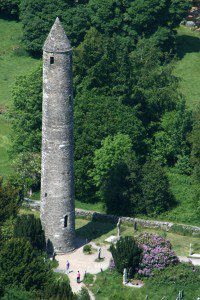I first heard of the notion of Thin Places the first time I visited Glendalough, the ancient monastery nestled in a glacial valley south of Dublin. We were there on a crisp October day, the forest filled with hardwoods dancing with autumn colors. Even as I stood in the carpark after first arriving, I could sense something special about the place; and when our tourguide told us about “thin places,” my eyes danced with the gleam of recognition.

“Glendalough is a thin place,” he said. “What is a thin place? It’s a sacred site, known to the Celts of ancient times, where the veil that separates our world from the otherworld, the world of silence and eternity, is particularly thin. So it’s a place where we can sense the nearness of the eternal.”
As I stood there at the edge of the forest, where it seemed that the memory of Saint Kevin and the other monks of Glendalough seemed especially present, I felt as if I knew, intuitively and deeply, just what he was talking about. And I had known this for years before. I knew it the first time I visited places like Chalice Well in the shadow of Glastonbury Tor, or the remarkable monument to the ancestors called Newgrange. I had sensed that Kildare, the home of St. Brigid and several beautiful holy wells, brought me face to face with the unseen realm. And yes, I’ve had that similar sense of mystery and wonder at other places I’ve visited over the years of my life.
Thin places, all of them.
Just the other day I read a blog post by a woman who’s unhappy with how people use the phrase “thin places.” She pointed to Richard Rohr (among others) who talk about “thin places” as a Celtic concept. She goes on to insist that the thin places exist before the Celts ever arrived in places like Ireland, so of course it had to be pre-Celtic in origin!
Sigh.
Celtic spirituality makes sense because it points us to something true and universal, something deeply human and at one with the radiance of heaven. So it’s a detour to get caught up on what is or isn’t authentically Celtic, as if that were the final arbiter of what is good and true and beautiful. Yes, there is a character, a distinctiveness, to Celtic language and myth and story and culture, and it’s good to celebrate what makes Celtic spirituality unique. But thin places matter not because they are Celtic (or pre-Celtic) — they matter because they are real, and point to something bigger than themselves.
The blogger’s other point may be a bit more reasonable: that thin places really are places. In other words, it doesn’t make sense to say “my heart is a thin place,” or even “my garden is a thin place, because that’s where I feel especially close to God.” Well, I hope your heart (and my heart, and everyone’s heart) is a place where we more readily touch eternity, and it’s always lovely to hear about places where people feel significant access to the breath of heaven — and a garden that you tend, mixing your own sweat with the moist soil of the good earth to nurture plants for joy and food — what place could take us closer to God than that?
But if just about every place could be a “thin place,” doesn’t that render the concept itself rather, well — pardon the pun — thin? So I see the blogger’s point: that certain places truly are holy places, numinous places, places of sacrality — a college word that means “pertaining to the sacred.” It’s what theologians call “the scandal of particularity.” It was originally applied to the Christian belief that Jesus is the one savior of all humankind — and even more than that, the one incarnation of the second person of the Trinity. Why would all people need just one particular savior? Because in this particular expression of God’s grace or God’s presence, the fullness of Divine Love is offered to all people. It’s the idea of a center — every circle has a center, and you need the center to draw the circumference. Jesus of Nazareth, at least for Christians, is the center of God’s saving love invading the universe and making all things possible. That’s not to say that God’s love doesn’t erupt in countless other ways: of course it does. But Jesus is still the ground zero point.
So thin places work in a similar way. There is a particular “thinness” that we encounter in places like Iona or Lindisfarne. Out of these think places, God’s Spirit invades the world at large. Of course your heart can also be a portal through which eternity flows into your life — indeed I hope every heart functions this way. And every garden, too, as well as every church.
But here’s something to think about: perhaps we more easily recognize the inflow of the Spirit through our hearts or our gardens or our neighborhood churches because, even if just once or twice in a lifetime, we visit places like Glendalough or St. David’s and there we find our hearts opened in a particular way — as if these places calibrate our spirits in such a way that we learn to recognize the whisper of the Holy, whenever or wherever it speaks to us.
Enjoy reading this blog?
Click here to become a patron.


















